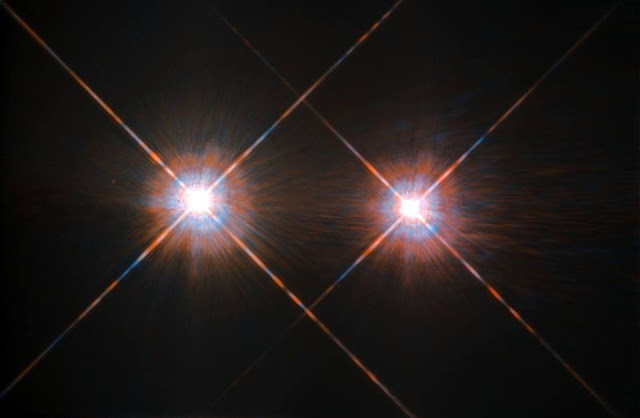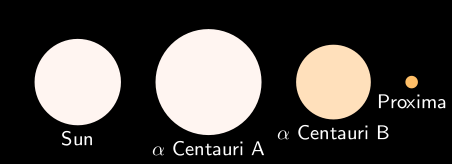The Best image of Alpha Centauri A and B
 |
| The Best image of Alpha Centauri A and B capture by the Hubble Space Telescope. Credit: ESA/Hubble & NASA |
The closest star system to the Earth is the famous Alpha Centauri group. Located in the constellation of Centaurus (The Centaur), at a distance of 4.3 light-years, this system is made up of the binary formed by the stars Alpha Centauri A and Alpha Centauri B, plus the faint red dwarf Alpha Centauri C, also known as Proxima Centauri.
The NASA/ESA Hubble Space Telescope has given us this stunning view of the bright Alpha Centauri A (on the left) and Alpha Centauri B (on the right), flashing like huge cosmic headlamps in the dark. The image was captured by the Wide Field and Planetary Camera 2 (WFPC2). WFPC2 was Hubble’s most used instrument for the first 13 years of the space telescope’s life, being replaced in 2009 by WFC3 during Servicing Mission 4. This portrait of Alpha Centauri was produced by observations carried out at optical and near-infrared wavelengths.
 |
| The relative sizes and colors of stars in the Alpha Centauri system, compared to the Sun. Wikipedia. |
Compared to the Sun, Alpha Centauri A is of the same stellar type G2, and slightly bigger, while Alpha Centauri B, a K1-type star, is slightly smaller. They orbit a common centre of gravity once every 80 years, with a minimum distance of about 11 times the distance between the Earth and the Sun. Because these two stars are, together with their sibling Proxima Centauri, the closest to Earth, they are among the best studied by astronomers. And they are also among the prime targets in the hunt for habitable exoplanets. Using the HARPS instrument astronomers already discovered a planet orbiting Alpha Centauri B. 24 August 2016 astronomers announced the discovery of an Earth-like exoplanet in the habitable zone orbiting the star Proxima Centauri. The Pale Red Dot Campaign provides more information on the newly discovered planet.
Sources: ESA/Hubble & NASA, Wikipedia
------------------------------------------------------------------------------------------------------
La mejor imagen de Alfa Centauri A y B
Grupo Alpha Centauri. Situado en la Constelación de Centaurus (El Centauro) a una distancia de 4,3 años luz, este sistema esta compuesto por las binarias de Alfa Centauri A y Alfa Centauri B, y por la débil y tenue enana roja de Alfa Centauri C, también conocida como Próxima Centauri.
El telescopio espacial Hubble de la NASA/ESA nos ha mostrado es impactante visión de la brillante Alfa Centauri A (En la izquierda) y de Alfa Centauri B (a la derecha), brillando como faros gigantes cósmicos en la oscuridad. La imagen fue tomada por la Cámara Planetaria y de Gran Angular 2 (WFPC2). WFPC2 fue el instrumento de Hubble más usado en sus primeros 13 años como telescopio espacial, este fue substituido en 2009 por el WFC3 durante la Misión de prestación de servicios al Telescopio Espacial Hubble 4. Esta foto de Alfa Centauri se llevó a cabo a través de observaciones que se realizaron en amplitudes de onda de rango óptico y en el cercano al infrarrojo.
 |
| Location of Alpha & Beta Centauri. |
Fuentes: ESA/Hubble & NASA, Wikipedia










